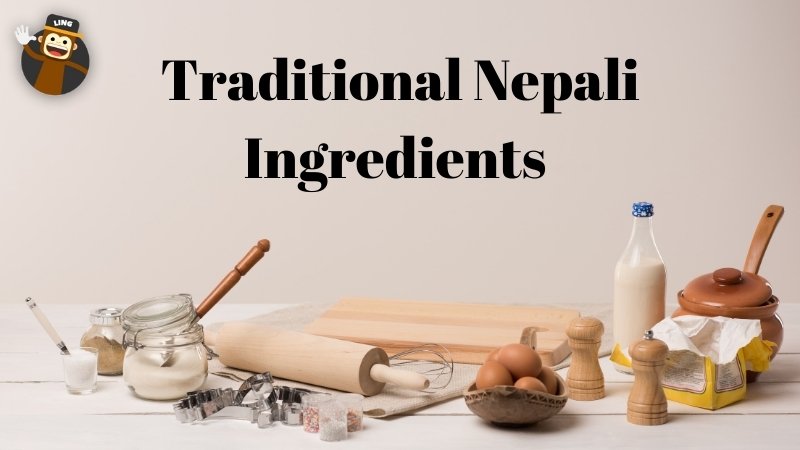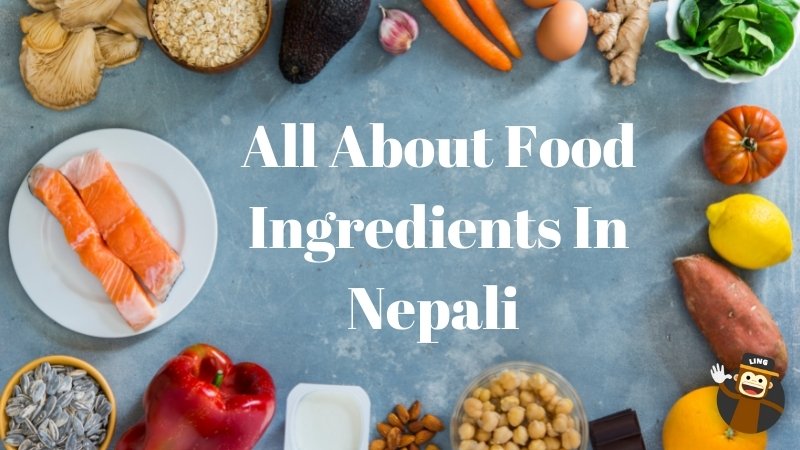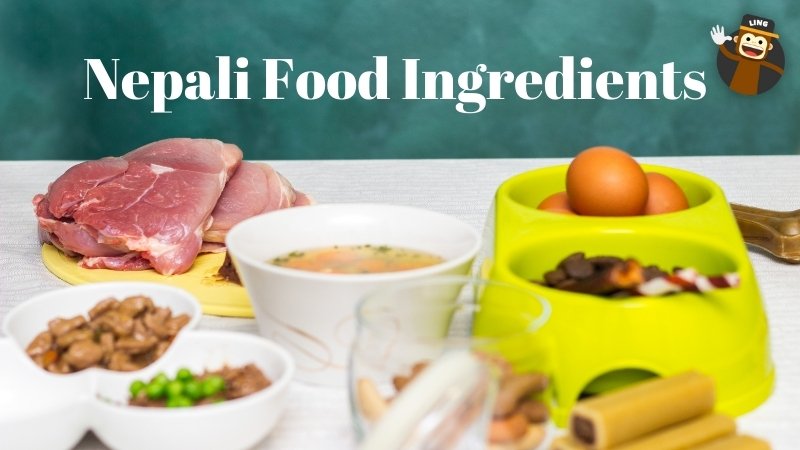Have you ever tried Nepali food like lentil soup, dal bhat, momo, vegetable curry, or aloo tama? If yes, you would know that nothing can compare to the beautifully blended ingredients concocted in Nepali foods, especially when it comes to spicy meal items. So, if you have a bucket list to visit Nepal anytime soon, we suggest you learn a little more about Nepalese cuisine, their language, and the traditional Nepali food ingredients that can become a great asset to you.
In this article, we learn about the national dish of Nepal and the essential vocabulary and facts about the food items such as लसुन (garlic), नुन (salt), बेसार (turmeric powder), etc., that each dish features. Knowing such words and facts will help you shortlist the dishes you want to try out. Want to learn more? Continue reading below!
Page Contents
- The Nepalese Cuisine And Cooking
- 5+ Traditional Nepali Food Ingredients
- Other Ingredients In The Nepali Kitchen
The Nepalese Cuisine And Cooking
Let us now have a quick brief about the unique culture of cooking that lies in a country between India and China, Nepal. From a deep-fried spring roll to a rice flour side dish, you find everything in the streets of Nepal that has nurtured excellent cooks and recipes. However, most people are unknown of the exciting facts about the traditional dish and cooking styles of Nepali food culture. So, below we will find a few points and tips that will help you get accustomed to the local taste of Nepali food.
1. Nepalese food mostly includes vegetarian items = Being a country filled with diverse people, it is a given that they have ethnic food with meat toppings, but most Nepali food is meat-free and is the best for vegetarian people.
2. Nepali cuisine is nothing without dal bhat = Dal bhat is mainly a dish consisting of rice and lentil soup, one of the most famous dishes you cannot oversee once you are in the country. Dal is the lentil soup, and bhat means boiled rice. The typical dal has an authentic taste that locals usually consume with rice during lunch as it is a rich source of carbs.
3. Dhindo and Ghundruk is the national staple dish of Nepali cuisine = It is a dish that is made of millet flour, buckwheat flour, and regular wheat flour. The nutritional value of Dhindo is very high and is prepared simply by boiling and stirring the mix.
4. Most dishes are influenced by Tibetan and Chinese cuisines. Many noodle soup food items come from these backgrounds.
Nepali Dishes You Must Try Out!
Here is a list of all the popular dishes from Nepali cuisine that you cannot miss out on! For detailed learning, check out best Nepali food.
- Dhindo- Served with various types of curries and meat.
- Sel roti- Traditional Bread-made sweet dish
- Momo- Type of dumpling
- Lafhing- Tibetan street food
- Sadheko Sukuti- Spicy meat dish
- Juju Dhau- Nepali yogurt
5+ Traditional Nepali Food Ingredients

In this section, we will go through some of the commonly used spices and condiments in Nepali cuisine. Each of the following items is something that is traditionally consumed and utilized to concoct local dishes by Nepali people daily. So, let’s get started.
1. Lentils – दाल
The first ingredient has to be lentils known as दाल- Dāla. It is the primary ingredient used in making Dal Bhat, and as already discussed, Nepali cuisine is incomplete without lentil soup. So, Lentils are among the traditional items that locals cannot live without.
2. Coriander – धनिया
The second most widely used food item is Coriander seed or leaves known as धनिया- Dhaniyā. It is used for garnishing in many dishes like lentil soup, fried rice, mashed potato, etc. It is popular because of the flavor and pleasant smell mostly added at the end of preparation.
3. Chili – खुर्सानी
When we say spicy, chilies will always be the first thing we think about. So, खुर्सानी, pronounced as Khursānī, is one of the traditionally used and eaten items by the Newari people. From vegetable curries to minced-meat spicy lafhings, the Newari culture cannot work without the original flavor of chilies.
4. Mustard Oil – तोरीको तेल
Just like the spices, Mustard oil, called Tōrīkō tēla, is a must-have item in the Newari Kitchen. It is extracted from mustard seeds तोरीको दाना (Tōrīkō dānā) and is used in every other dish like chicken curry, lentil soups, momos, etc.
5. Fenugreek seeds – मेथी
मेथी- Mēthī or Fenugreek seeds are another common ingredients that you will find in many dishes of Nepal. It is used fried or fresh to finish items like curries, meat dishes, and even sauces.
6. Turmeric – बेसार
When it comes to Indian or Nepali food, turmeric, known as Bēsāra, is one of the top ingredients you must have in your cabinets. It is used in almost every dish to give that beautiful yellowish tone and a taste that can make cravings a real deal. From fried vegetables to chicken rice, turmeric can be smelled everywhere.
7. Potatoes – आलु
Other than spices, potatoes- Ālu also play a massive role in the Newari kitchen. It is used on many plates, and even simple boiled potatoes are eaten regularly by the locals. One of the most popular potato dishes is Saadheko-Aalu, made by mixing potato with spices. Even meat and potato curries are quite the hype.
8. Ajwain Seeds – अजवाइनको बीउ
Ajwain seeds or Ajavā’inakō bī’u are also frequently used in Nepalese cooking. It is similar to cumin and fennel seeds and has a strong fragrance that makes the food delicious and flavorful.
9. Rice – चामल
Just like any other Asian country, Nepal also loves rice to its core. Cāmala is one of the main items that can be counted in regular Nepali staples, consumed as steamed rice with dal, fried rice, pulao, etc. No matter where you go, every restaurant will have rice servings as their main course.
10. Corn – मकै
मकै- Makai, or Corn in Nepali cuisine, is another religiously used ingredient. It is cooked and consumed in various ways, like boiled, fried, or even grilled. Corn flakes, corn flour, and corn rice grains are also quite popular in Nepal.
Other Ingredients In The Nepali Kitchen

Now that we know some commonly used ingredients of the Nepali kitchen, below is a list of all common spices and vegetables that a conventional kitchen has in its store. Learning these will improve your vocabulary and give you a more comprehensive view of the Nepali language.
Condiments – मसलाहरू (Masalāharū)
Nepali food cannot persist without spices. Below is the list of spices that are less commonly known in Nepal but are inevitably present in most dishes.
Fruits- फलहरू (Phalaharū)
Vegetables- तरकारी (Tarakārī)
Leafy Greens- पातदार हरियो (Pātadāra hariyō)
Apart from spices, Nepali food also feature a lot of greens. These items make the food healthy, tasty, and even colorful. No wonder Nepali food looks attractive from a thousand miles away!
Meat – मासु (Māsu) And Seafood – समुद्री खाना (Samudrī khānā)
Nepal is the go-to place for non-vegetarians from masala meat curry to spicy fish chutney, you will find everything on the Newari table.
Wrapping Up!
So there you go! Now you know the translations and how to pronounce different ingredients in the Nepali language. Learning these will surely enhance your language skills and unlock a power that will allow you to explore Nepali cuisines freely.
If you think this blog was helpful, don’t forget to look into other blog posts by the Ling App, such as emergency phrases, business vocab, music culture, and many more. Just download the app from App Store or Play Store and enjoy your reading journey!
Learn With Ling App

Wondering what the Ling App is? Don’t worry. It is nothing out of the world but a simple application filled with out-of-the-box content to make you a pro speaker in just a few days. You can choose any language you prefer, from Nepali to Swahili, and start learning for free. They hire expert writers from all over the world to produce the best content to ensure that your skill will be enhanced asap!
Moreover, it features multimedia content such as audio, videos, and images and an AI interactive chatbot that makes learning super fun and exciting. If you want to try these resources and features, don’t wait, and start learning Nepali with Ling today!



































































